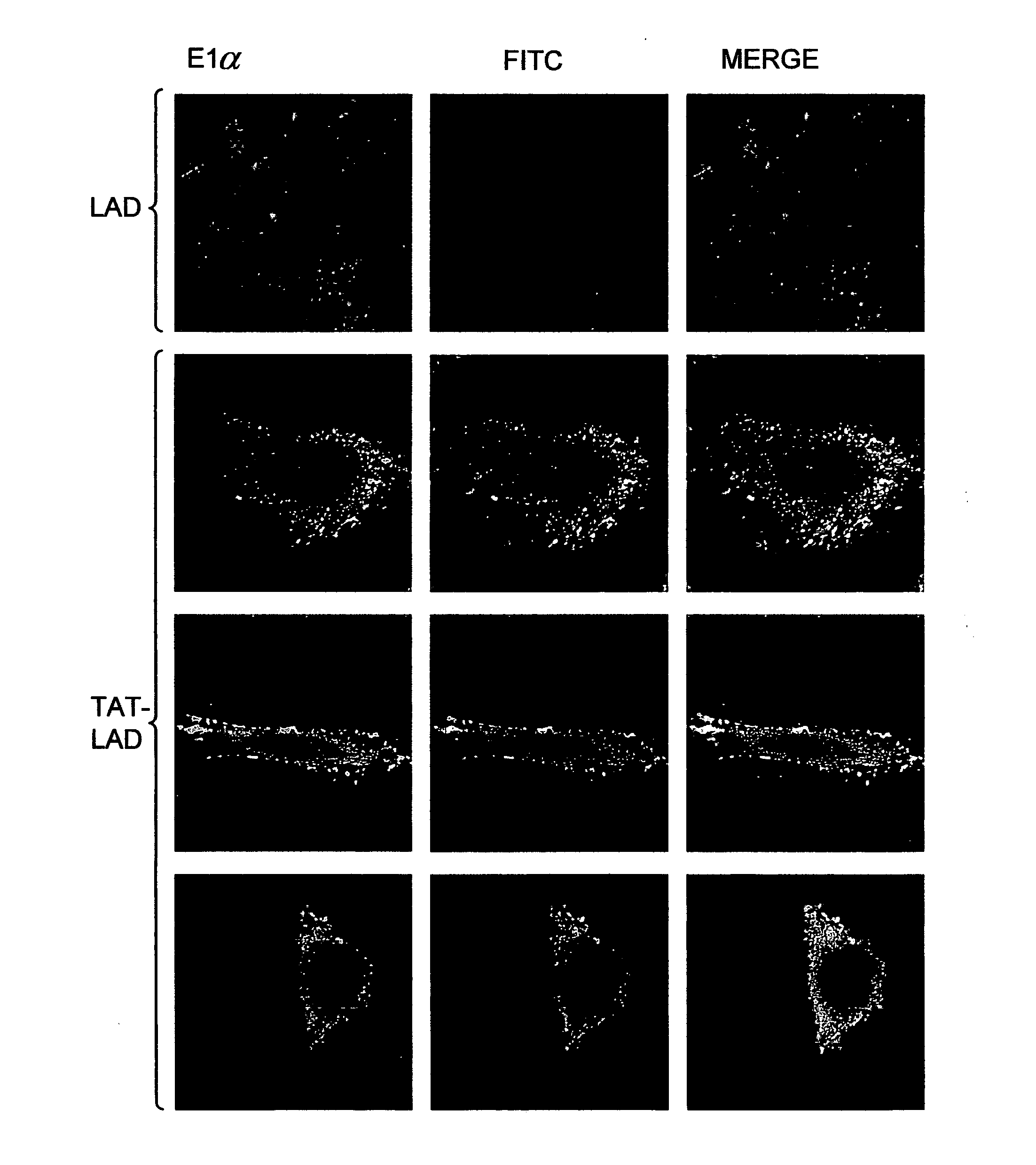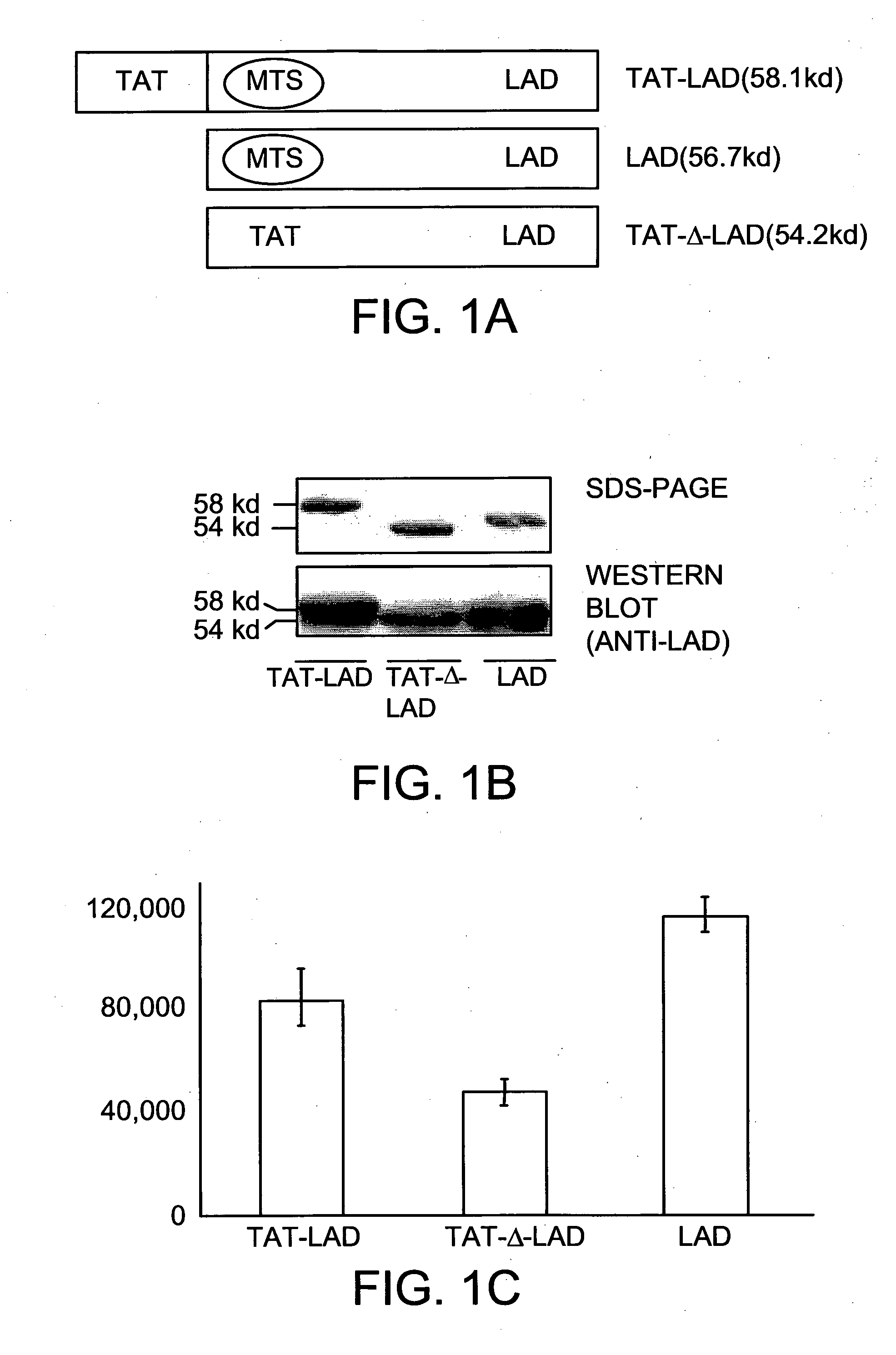Methods and compositions for treatment of mitochondrial disorders
a mitochondrial disorder and composition technology, applied in the field of fusion proteins, can solve the problems of no cure for genetic mitochondrial metabolic disorders, no cure, no cure, etc., and achieve the effects of enhancing lad activity, restoring activity to nearly normal levels, and high purification
- Summary
- Abstract
- Description
- Claims
- Application Information
AI Technical Summary
Benefits of technology
Problems solved by technology
Method used
Image
Examples
examples 1-4
Cell Culture
[0079]Fibroblast primary culture cells of patients bearing the mutated genotypes G229C / Y35X, E375K / E357K and D479V / D479V were established from forearm skin biopsies. Cells were maintained in DMEM (Biological Industries, Beit-Haemek, Israel) supplemented with 15% Fetal Bovine Serum (HyClone, Logan Utah, USA), penicillin / streptomycin and L-glutamine (Biological Industries, Beit-Haemek, Israel) in a humidified atmosphere with 5% CO2 at 37° C. All cell cultures tested negative for mycoplasma contamination. All experiments involving patients' cells were approved by the Hadassah University Hospital ethical review committee.
Construction of Plasmids Expressing TAT-LAD and LAD Proteins.
[0080]TAT fusion proteins were generated using the pTAT plasmid, provided by Dr. S.F. Dowdy. The plasmid contains a gene encoding a 6-histidine His-tag, followed by the TAT peptide (AA 47-57). To construct a pTAT plasmid with LAD fused to the His-tagged TAT peptide, the gene for human LAD precursor...
example 1
Construction, Expression, Purification and In-Vitro Activity of TAT-LAD and LAD Proteins
[0094]Over-expression and purification of the fusion protein TAT-LAD was accomplished by inserting the precursor human LAD sequence into the pTAT vector. Expression vectors encoding TAT-Δ-LAD, lacking the MTS sequence, and a control LAD protein lacking the TAT peptide were also constructed (FIG. 1A). These proteins were all expressed and highly purified under the same conditions. Sodium dodecyl sulfate polyacrylamide gel electrophoresis analysis and Western blotting confirmed the identity of these highly purified proteins (FIG. 1B). These purified LAD-based fusion proteins were found to be highly active in an in vitro LAD enzymatic activity assay (FIG. 1C).
example 2
Delivery of TAT-LAD into LAD Deficient Cells
[0095]The next experiment examined the ability of protein transduction domains (PTD's) such as TAT to deliver the human LAD enzyme into cultured cells from patients with LAD deficiency. Purified TAT-LAD was incubated for different time periods with cells from patients heterozygous for the G229C / Y35X and E375K LAD mutations. Whole-cell protein extracts were prepared and analyzed by Western blotting using anti-LAD antibodies. TAT-LAD fusion protein (58 kDa) rapidly entered G229C / Y35X cells and was detectable after 30 minutes of incubation (FIG. 2A). In cells homozygous for the E375K mutation (FIG. 2B), its delivery was somewhat slower; it was detected within the cells after a 2-hour incubation. Endogenous mutated LAD (50 kDa) was detected only in G229C / Y35X cells and not in E375K cells (FIG. 2A). In both cell lines, steady state was reached after 2-3 hours; thus, the amount of the fusion protein remained similar through the 6-hour (FIG. 2A) ...
PUM
| Property | Measurement | Unit |
|---|---|---|
| Disorder | aaaaa | aaaaa |
| Enzyme activity | aaaaa | aaaaa |
Abstract
Description
Claims
Application Information
 Login to View More
Login to View More - R&D
- Intellectual Property
- Life Sciences
- Materials
- Tech Scout
- Unparalleled Data Quality
- Higher Quality Content
- 60% Fewer Hallucinations
Browse by: Latest US Patents, China's latest patents, Technical Efficacy Thesaurus, Application Domain, Technology Topic, Popular Technical Reports.
© 2025 PatSnap. All rights reserved.Legal|Privacy policy|Modern Slavery Act Transparency Statement|Sitemap|About US| Contact US: help@patsnap.com



